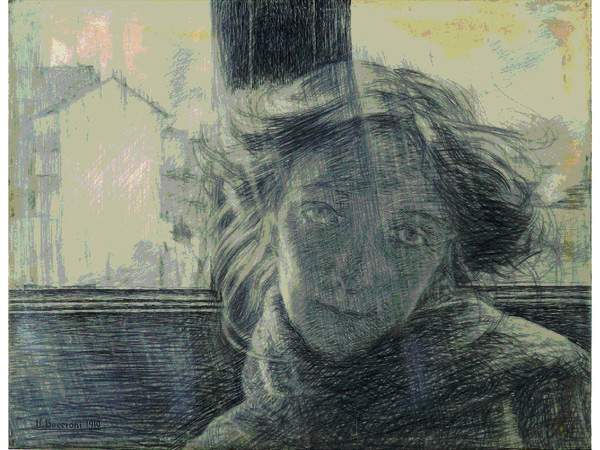From Boccioni to Castellani, never-before-seen drawings of the great 20th century in Milan, from an important private collection
From Nov. 23, 2018 to Feb. 24, 2019, the Museum of the Twentieth Century in Milan is hosting a major exhibition dedicated to works on paper of the Italian 20th century from the Ramo Collection. With more than one hundred works, from Boccioni to Paolini, via Savinio, Fontana, Melotti, Rama, Castellani, Mauri, Agnetti, Mondino, Schifano, Pascali, Boetti, Salvo and many others, Milan’s extraordinary private collection is revealed to the public for the first time, while also presenting an important publication with the Collection’s general catalog.
Who’s Afraid of Drawing? This is the intentionally provocative title, which mocks the low consideration given to drawing, which will be presented in the exhibition in an unusual light. In fact, the choice of works and the colorful arrangement outside the traditional modes intend to give drawing the importance it deserves in art history and enhance its enjoyment.
Who’s Afraid of Drawing? presents the public with a wide selection of works by the most representative Italian artists of the 20th century, and others yet to be rediscovered, from the prestigious Ramo Collection, one of the largest private collections of works on paper of the 20th century, started a few years ago by Milanese entrepreneur Pino Rabolini. With about 600 works, starting from the early 20th century, the collection follows the footsteps of the major protagonists of the historical avant-garde until the early 1990s. The purpose of the collection is to testify to the great importance of Italian art of the last century by promoting a culture of drawing with an autonomous value on par with painting and sculpture.
The exhibition is divided into four sections in the form of open-ended questions: “Abstractions?”, “Figurations?”, “Words + Images = ?” and, “What about the sculptors?” The exhibition intends for the works themselves to answer the questions arising from the visual association of abstract and figurative forms from different eras to put them in dialogue with each other. The four divisions of the exhibition are in the plural and followed by the question mark because they do not refer to precise movements, but open to new explorations, precisely so as not to flatten an artist’s personal vision on the name of a single movement.
The public will have the opportunity to appreciate unpublished and great masterpieces that offer a new reading of artists known mainly for their production on canvas such as Cagnaccio di San Pietro, Tancredi, Gnoli, Burri, or for sculpture such as Wildt, Marini, and Consagra. For some artists it was preferred to exhibit works from their younger years or the late production that reveals very interesting and unpublished aspects. There will also be the opportunity to see the very interesting production of artists such as Rho, Munari or the production on paper of artists known for installations with poor materials such as Merz, Kounellis, Anselmo and Calzolari.
Given the recent death of collector Pino Rabolini, this first major presentation of the Ramo Collection also takes on the significance of celebrating the very person who, with sensitivity and foresight, had believed in the strength and unique qualities of drawing. Who’s Afraid of Drawing? also sees the lively and unexpected intervention of Virgilio Villoresi, who has created a paper video animation, a sort of dreamlike homage to the Ramo Collection: Sogni di Segni (Dreams of Signs ) presents drawing in the form of a dream, playing on the works and colors of fourteen artists in the exhibition. In the video, which features the exceptional presence of its author, the protagonists are two hands that, with paper, brushes and various kinds of colors literally bring some of the drawings in the Collection to life, thus creating an effective and lively dialogue between the various works.
The Museum of the Twentieth Century’s collection offers visitors the opportunity for direct comparison with the paintings and sculptures in the permanent collection, whose authors largely coincide with those in the Ramo Collection. At the same time as the exhibition, the Ramo Collection presents the publication Disegno Italiano del XX secolo, edited by Irina Zucca Alessandrelli and published by Silvana Editoriale, which traces a real journey through the history of Italian drawing, starting with the works in the collection.
The exhibition Who’s Afraid of Drawing? can be visited daily with the entrance ticket to the Museo del Novecento and with free guided tours for families and children, curated by Ad Artem. Offered by the Ramo Collection and the Belleville School of Writing, the activities start with a tour that takes in the works on display in the exhibition and the permanent collection, and continue with an educational workshop differentiated according to the age of the participants (for info and reservations www.chihapauradeldisegno.it/didattica).
For the occasion, the collection’s website www.chihapauradeldisegno.it and Instagram profile (collezioneramo) have also been created to stay up-to-date on the exhibitions and activities of the prestigious Milanese collection. The exhibition, as mentioned, will be open from November 22, 2018 to February 24, 2019. For all information you can send an email to c.museo900@comune.milano.it or visit www.museodelnovecento.org.
Pictured: Umberto Boccioni, Controluce (1919)
 |
| From Boccioni to Castellani, never-before-seen drawings of the great 20th century in Milan, from an important private collection |
Warning: the translation into English of the original Italian article was created using automatic tools. We undertake to review all articles, but we do not guarantee the total absence of inaccuracies in the translation due to the program. You can find the original by clicking on the ITA button. If you find any mistake,please contact us.





























